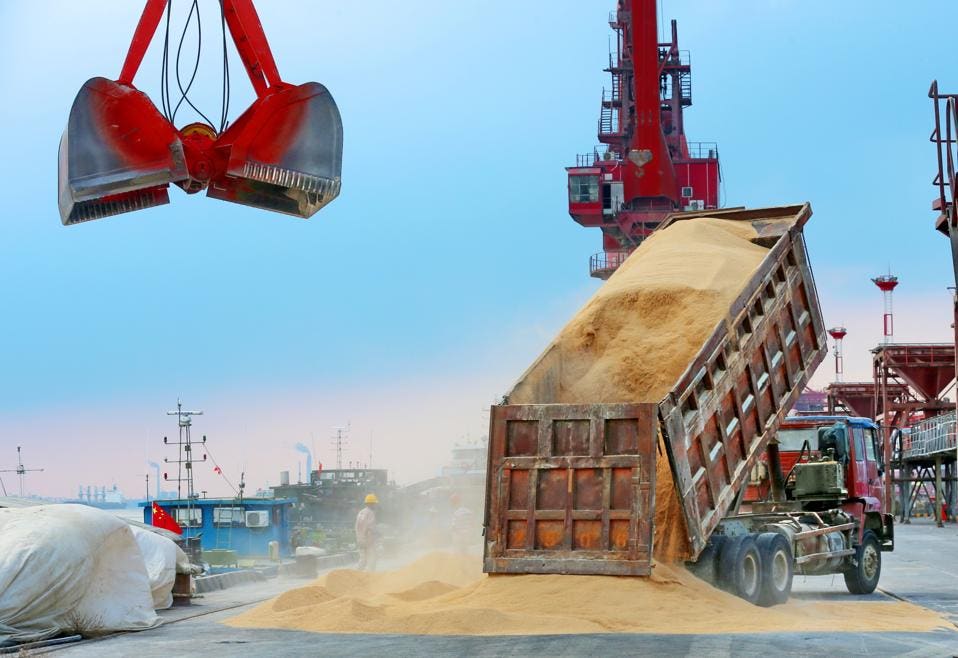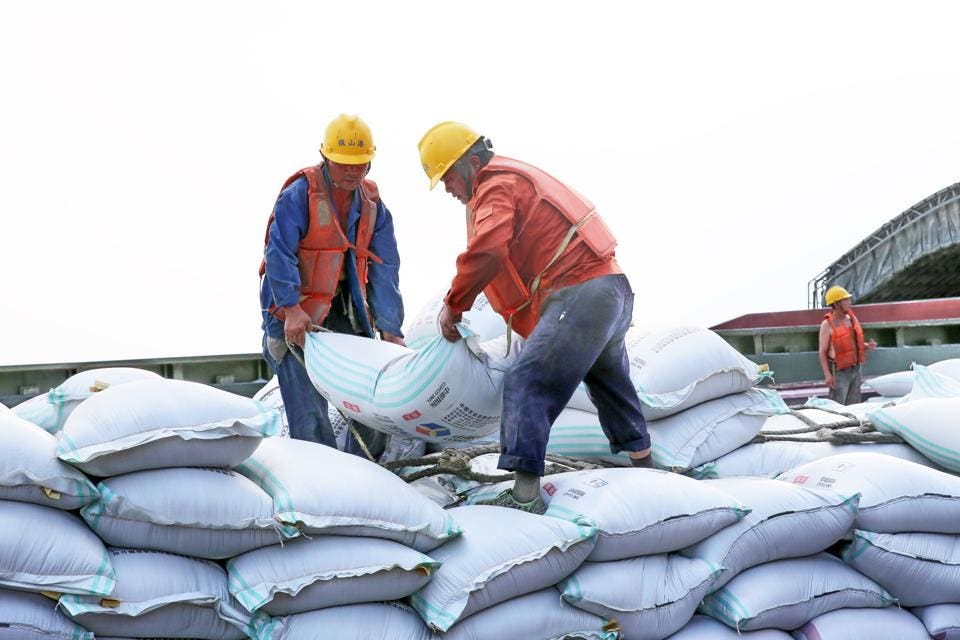- Beranda
- Komunitas
- News
- Berita Luar Negeri
Trade War Update: China May Have Shot Self In Foot
TS
hahaiyaa.20
Trade War Update: China May Have Shot Self In Foot
Trade War Update: China May Have Shot Self In Foot

China uses soy for oil, for animal and fish food, and for human consumption. Thanks to 25% tariffs on their top market, American soy, they will now have to pay more for it in Brazil.
China made a “dumb move” in targeting America’s heartland with tariffs. Soybeans are a case in point.
“I understood politically why they chose soybeans, but they made a dumb move,” says John Baize, a market analyst with the U.S. Soybean Export Council. The U.S. is the number one exporter of soybeans. Brazil is number two. No one comes close after that except for Argentina, which is the largest exporter of soymeal and soybean oil.
Soybeans don’t fall from the sky, so China has very little mega-markets outside of the U.S. Brazil is the only one, really. And now they are paying more for soy at a time when soy prices are near rock bottom thanks to record acreage and harvest sizes in Brazil and the U.S.
Soy is the number one item China buys from the U.S. and a top three item from Brazil. That alone stands as a testament to just how important that crop is to feed not only the Chinese but Chinese fish and Chinese livestock that live on the stuff.
“What’s going to happen is that if they don’t buy from the U.S. they will be short by about 20%,” estimates Baize. “This will impact feed grain and food in general, and the Chinese will pay the price for that,” he says.
China has up to two years worth of reserve stocks. They could dig into those instead of buying. But then they will just need to replenish those reserves next year, meaning more demand and the likelihood of rising soybean prices.
The U.S. could, in theory, lose some China market share to Brazil. But as Brazil soy is not limitless and low prices have many traders holding onto what they have anyway, they will end up selling less to Europe, the world’s No. 2 soy market after China. Less Brazil beans to Europe means more American beans to Europe. As the U.S. risks losing China market share to Brazil, so Brazil risks losing European market share to the Americans.
The 25% tariff on soybeans is almost entirely priced into the price difference between U.S. soy and Brazilian soy.color=red]Brazilian soy always costs more [/color]simply because it is harder to get it out of the country. Today, soy prices in Brazil cost at least $2.60 more per bushel.
The price differential is all because of Trump’s trade war and China’s retaliation. The last time the spread between Brazilian soy and American soy was this high was back in 2014 when the U.S. supply shrunk to near historic lows.
“Trump has really confused the market, and that’s why prices are higher here now,” says Mauro Ulian, a commodities broker with Nova Futura Investimentos in São Paulo. A trucker’s strike in Brazil earlier this year also impacted soy premium prices, but nothing like the effect Trump has had.
Normally prices ebb and flow with harvest season. This year is different. Trump sent prices higher, even though Chinese demand is not any greater than it’s been before. “It is definitely not because of Chinese demand. Chinese demand for Brazil soy is within historic norms; nothing exceptional,” says Ulian.
China may end up buying from the U.S. and paying the price.==>STUPID Sickmen of Asia!!!
“I’ll say this much, Trump has been a positive force for Brazilian farmers,” says Samuel Garcia Filho, a commodity broker with H.Commcor in São Paulo. “Low soy prices have been made up for by the rise in premium prices. For the Americans, we are hearing that Brazil-based exporters will buy from the U.S. cheap and sell to the Chinese high if they have to.”
Over the last few years, roughly 75% of Brazil soy was shipped to China. That number is expected to go to 90% this year, according to Agribusiness Intelligence Informa in Sao Paulo.
“Brazil will have the most expensive soy in the world," says Aedson Pereira, a market analyst with Informa. “The higher cost will probably restructure the global soy trade. The EU, Japan, Mexico and the countries of southeast Asia will likely focus their attention on buying from the U.S. instead,” he says.

In 2017, Brazil exported 53.8 million tons of soy to China. This year, that number is expected to be around 66 million tons even though China is not really saving much by buying there. More Brazil soy to China means less soy elsewhere. The U.S. soy farmer will gladly sell where the Brazilians are not.

Workers transfer sacks of animal feed made from Brazil soybeans at a port on August 6, 2018, in Nantong, Jiangsu Province of China. Trade frictions between China and the United States lead to increased cost of imported soybeans, and China is expected to reduce imports of soybeans by over 10 million metric tons this year.
The biggest problem for American soy producers is not the tariff. It’s soybean oversupply.
Soy futures are expected to fall a little further if the U.S. harvest this fall is as good as the market forecasts. Soy prices are around $8.38 a bushel in the U.S. and over $10.50 per bushel in Brazil. China effectively gave itself a global soybean tariff.
Derek Sawyer, a soy farmer in McPherson, Kansas, says tariffs are going to be a problem. “It’s hard for me to see into the future right now and know how this trade war with China is going to help us,” he says.
haiyaaa ciilaaka luuwa weelas waaa
kata nyeee SICKmen of Asia,DUMB waaa????


China uses soy for oil, for animal and fish food, and for human consumption. Thanks to 25% tariffs on their top market, American soy, they will now have to pay more for it in Brazil.
China made a “dumb move” in targeting America’s heartland with tariffs. Soybeans are a case in point.
“I understood politically why they chose soybeans, but they made a dumb move,” says John Baize, a market analyst with the U.S. Soybean Export Council. The U.S. is the number one exporter of soybeans. Brazil is number two. No one comes close after that except for Argentina, which is the largest exporter of soymeal and soybean oil.
Soybeans don’t fall from the sky, so China has very little mega-markets outside of the U.S. Brazil is the only one, really. And now they are paying more for soy at a time when soy prices are near rock bottom thanks to record acreage and harvest sizes in Brazil and the U.S.
Soy is the number one item China buys from the U.S. and a top three item from Brazil. That alone stands as a testament to just how important that crop is to feed not only the Chinese but Chinese fish and Chinese livestock that live on the stuff.
“What’s going to happen is that if they don’t buy from the U.S. they will be short by about 20%,” estimates Baize. “This will impact feed grain and food in general, and the Chinese will pay the price for that,” he says.
China has up to two years worth of reserve stocks. They could dig into those instead of buying. But then they will just need to replenish those reserves next year, meaning more demand and the likelihood of rising soybean prices.
The U.S. could, in theory, lose some China market share to Brazil. But as Brazil soy is not limitless and low prices have many traders holding onto what they have anyway, they will end up selling less to Europe, the world’s No. 2 soy market after China. Less Brazil beans to Europe means more American beans to Europe. As the U.S. risks losing China market share to Brazil, so Brazil risks losing European market share to the Americans.
The 25% tariff on soybeans is almost entirely priced into the price difference between U.S. soy and Brazilian soy.color=red]Brazilian soy always costs more [/color]simply because it is harder to get it out of the country. Today, soy prices in Brazil cost at least $2.60 more per bushel.
The price differential is all because of Trump’s trade war and China’s retaliation. The last time the spread between Brazilian soy and American soy was this high was back in 2014 when the U.S. supply shrunk to near historic lows.
“Trump has really confused the market, and that’s why prices are higher here now,” says Mauro Ulian, a commodities broker with Nova Futura Investimentos in São Paulo. A trucker’s strike in Brazil earlier this year also impacted soy premium prices, but nothing like the effect Trump has had.
Normally prices ebb and flow with harvest season. This year is different. Trump sent prices higher, even though Chinese demand is not any greater than it’s been before. “It is definitely not because of Chinese demand. Chinese demand for Brazil soy is within historic norms; nothing exceptional,” says Ulian.
China may end up buying from the U.S. and paying the price.==>STUPID Sickmen of Asia!!!

“I’ll say this much, Trump has been a positive force for Brazilian farmers,” says Samuel Garcia Filho, a commodity broker with H.Commcor in São Paulo. “Low soy prices have been made up for by the rise in premium prices. For the Americans, we are hearing that Brazil-based exporters will buy from the U.S. cheap and sell to the Chinese high if they have to.”
Over the last few years, roughly 75% of Brazil soy was shipped to China. That number is expected to go to 90% this year, according to Agribusiness Intelligence Informa in Sao Paulo.
“Brazil will have the most expensive soy in the world," says Aedson Pereira, a market analyst with Informa. “The higher cost will probably restructure the global soy trade. The EU, Japan, Mexico and the countries of southeast Asia will likely focus their attention on buying from the U.S. instead,” he says.


In 2017, Brazil exported 53.8 million tons of soy to China. This year, that number is expected to be around 66 million tons even though China is not really saving much by buying there. More Brazil soy to China means less soy elsewhere. The U.S. soy farmer will gladly sell where the Brazilians are not.

Workers transfer sacks of animal feed made from Brazil soybeans at a port on August 6, 2018, in Nantong, Jiangsu Province of China. Trade frictions between China and the United States lead to increased cost of imported soybeans, and China is expected to reduce imports of soybeans by over 10 million metric tons this year.
The biggest problem for American soy producers is not the tariff. It’s soybean oversupply.
Soy futures are expected to fall a little further if the U.S. harvest this fall is as good as the market forecasts. Soy prices are around $8.38 a bushel in the U.S. and over $10.50 per bushel in Brazil. China effectively gave itself a global soybean tariff.
Derek Sawyer, a soy farmer in McPherson, Kansas, says tariffs are going to be a problem. “It’s hard for me to see into the future right now and know how this trade war with China is going to help us,” he says.
haiyaaa ciilaaka luuwa weelas waaa
kata nyeee SICKmen of Asia,DUMB waaa????


Diubah oleh hahaiyaa.20 16-08-2018 08:47
anasabila memberi reputasi
1
1.8K
22
Guest
Tulis komentar menarik atau mention replykgpt untuk ngobrol seru
Urutan
Terbaru
Terlama
Guest
Tulis komentar menarik atau mention replykgpt untuk ngobrol seru
Komunitas Pilihan